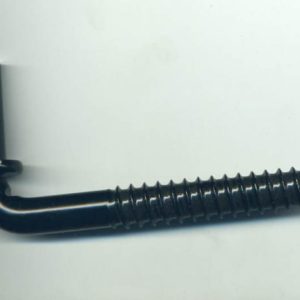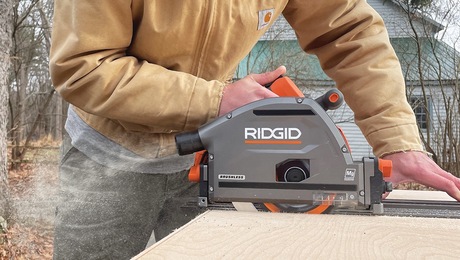epoxy into brick or mortar joint?
Hi all,
My wife and I are looking into mounting a hand-forged steel trellis outdoors onto a brick wall. The trellis weighs about 100 pounds and will be held up by four pins -1/2 ” diameter x 3″ long, like the one in the attached photo – epoxied into the wall.
The question is, is it better to drill and epoxy into the brick or the mortar joint? My wife, thinking ahead as usual, says that if ever the trellis and pins are removed permanently by some future homeowner, the remaining holes would be easier to patch in a mortar joint than in the brick. But would the bricks would be a stronger substrate for holding the pins and the weight of the trellis?
Thanks for any advice!
Kyle
“Argue for your limitations, and sure enough they’re yours.”
Edited 8/24/2009 2:01 pm ET by KylefromKy



















Replies
Your wife has it correct.
I think I could patch either just as effectively, but to install, I'd rather the mortar joint myself
Welcome to the
Taunton University of Knowledge FHB Campus at Breaktime.
where ...
Excellence is its own reward!
A hundred pounds is not that much -- only 25 lbs/anchor. You may want to simply use lead anchors in the mortar (if it's in good shape) if you're worried about patching it later.
Mike Hennessy
Pittsburgh, PA
Everything fits, until you put glue on it.
What Mike says about the lead anchors. With 'poxy, you got a high chance of the stuff dribbling out and messing up your brickwork.
Mike: How should he align these anchors? With the sleeve's joint inline with the mud line or against? Or IOW, hortizonally or vertically?
"With 'poxy, you got a high chance of the stuff dribbling out and messing up your brickwork."
Plus, if you ever want to remove it down the road, you're gonna have to make a lot bigger mess than you would just popping out a lead anchor. I doubt you could even unscrew the mounts if they were bedded in epoxy. Way easier to patch a small lead anchor hole than a honkin' blast crater from blowing out the epoxy. ;-)
"How should he align these anchors?"
Lead's soft enough that it doesn't really matter where the slot is -- the whole thing just deforms as opposed to wedging in any particular direction. If you're worried about cracking due to the wedging action, I'd just pay more attention to getting the hole sized right & not too small for the assembly.
Mike HennessyPittsburgh, PAEverything fits, until you put glue on it.
Edited 8/25/2009 9:43 am ET by MikeHennessy
Wow, thanks for the replies. Seems like attaching to mortar is the unanimous answer.
As far as lead anchors are concerned, is there a particular type of anchor anyone would recommend? The pins are 1/2" diameter, so the anchors would need to be bigger, obviously, to accept the pins, maybe 5/8"? I'm wondering what the outer diameter of the correct size anchor will be, and if it is still going to be safe to drill a hole that size. The mortar joints are about 3/8 to 1/2" thick, so any hole bigger than that will be removing some of the brick as well. Could that be a problem?
"Argue for your limitations, and sure enough they're yours."
If the pins are 1/2", you're gonna hit some brick -- no way around it -- since the anchors are prolly gonna be around 3/4". The anchors are pretty generic and sized per the size of the fastener going into them.
That said, at only 100 lbs for the grillwork, you're definately going for overkill on the pins. Don't see why 3/8", or even 1/4", wouldn't work fine.
I didn't think it was worth mentioning before, but if you have decent wood sheathing behind the masonry, you may be able to get longer pins that screw directly into the wood through a closely-sized hole in the masonry and skip the anchors/epoxy altogether.Mike HennessyPittsburgh, PAEverything fits, until you put glue on it.
Good points. I don't know what's inside the wall. This is someone else's house. I'll confer with my wife about the smaller pins.
Thanks!
"Argue for your limitations, and sure enough they're yours."
Just another vote for what the others above said. Drilling directly into a brick will likely crack it unless you are very careful and a little lucky. Attach to mortar joint and use smaller anchors. Drilling a 5/8" or 3/4" hole into a 3/8" mortar joint could possibly crack the brick work (brick and/or mortar). Even still, you need to take it easy as you drill.
It depends on the mortar. My current house is brick and the mortar is pretty soft.
So I drill and attach to the brick.
It also depends on the fastener. Your fasteners are pretty large so the mortar might be fine.
When I attach things to masonry I start with what will work for the application but many times I've had to adapt as I go.
If you get one done but are not satisfied, try something else. If it seems to not be strong enough it probably isn't.
Masonry strength is so random that it is best to try one and see. "There are three kinds of men: The one that learns by reading, the few who learn by observation and the rest of them have to pee on the electric fence for themselves."Will Rogers
Thanks for the reply.
The mortar is pretty hard on this house, but I'll keep your suggestions in mind.
"Argue for your limitations, and sure enough they're yours."
Putting anchors into brick always has a chance of cracking; go with the mortar.
At the risk of beating this dead horse, mortar joints, for sure.
I refuse to accept that there are limitations to what we can accomplish. Pete Draganic
Take life as a test and shoot for a better score each day. Matt Garcia
I am surprised nobody mentioned Tapcon type screws, 1st thing I thought of. Drill a number of 3/16" holes and you are done. Or am I missin sumthin, again?
Yeah, I thought of those too. They're so easy to use, but in this application the trellis is being kept about 2" away from the wall to allow for stuff to grow around it, so the tapcons wouldn't work.
Thanks for the reply!
"Argue for your limitations, and sure enough they're yours."
The reason nobody suggested Tapcons is you specified that you wanted to use those 1/2" angle pins to support the trellis. Your wife (or somebody) is custom building the trellis, right? One common way these are built includes standoffs with screw fittings. The only reason I can think of for using the pins you originally described is if you want to be able to lift the trellis off the mounts, or have it pivot like a door on the pins. If you're not married to the angle pins, standoffs and Tapcons may be the best way to go. Mike HennessyPittsburgh, PAEverything fits, until you put glue on it.
You are right on the money. Sorry I didn't mention all that at first. My wife, a blacksmith, is building the trellis, and it needs to be removable so it can be repainted occasionally. Sounds like you've been there and done that!
"Argue for your limitations, and sure enough they're yours."
Edited 8/27/2009 11:35 am ET by KylefromKy
"Sounds like you've been there and done that!"
Couple of times. Made decorative iron window bars for a couple of houses I owned (and a few for neighbors) once in a neighborhood where that sort of thing needed to be functional and not just decorative. ;-)
Still, since you have the blacksmith "on payroll", so to speak, I'd see what she thinks about standoffs with drilled mounting flanges. You could use wedge anchors with bolts to secure it to the wall. Easy to remove that way -- just spin off 4 bolts. Look here:
http://www.concretefasteners.com/anchors-fasteners/thunderstud-wedge/pricing.aspx?gclid=CKCb9_2XxJwCFaBC5god1jNvnQ
Mike HennessyPittsburgh, PAEverything fits, until you put glue on it.
Interesting. So the anchors stay tight after the bolts are removed, and can be safely re-used?
The manufacturer's FAQ says to use the wedge anchors only in solid concrete. http://www.concretefasteners.com/anchors-fasteners/thunderstud-wedge/faqs.aspx
Would they still work in mortar?
"Argue for your limitations, and sure enough they're yours."
Yep, they stay. I've used these to hold such things as my lumber racks on my shop walls. They're mounted into concrete block and the total load is several hundred pounds per fastener. Your load is so light, you shouldn't have any problem with these in mortar -- if the mortar is good.
You can also just epoxy stainless allthread into a hole drilled into the mortar joint and mount the trellis with bolts per my previous post. If you ever want to remove 'em, just grind 'em off and touch up the mortar.
There ya go -- full circle back to the epoxy idea! ;-)Mike HennessyPittsburgh, PAEverything fits, until you put glue on it.
Thanks for all the ideas. I love your quote about glue- so true!
"Argue for your limitations, and sure enough they're yours."
So, why not use Tapcons to fasten a cleat to the wall, thus getting the 2" offset, then run screws into the cleat to hang the thing.
Just a thought, I like tapcons.
If a lead anchor is going to sit proud of the brick by 2", won't the anchor sag over time? Just wondering.
I don't think the Tapcons can be removed and re-used can they?
The anchor would be set completely into the wall, with a steel pin protruding 2".
"Argue for your limitations, and sure enough they're yours."
Edited 8/27/2009 9:16 pm ET by KylefromKy